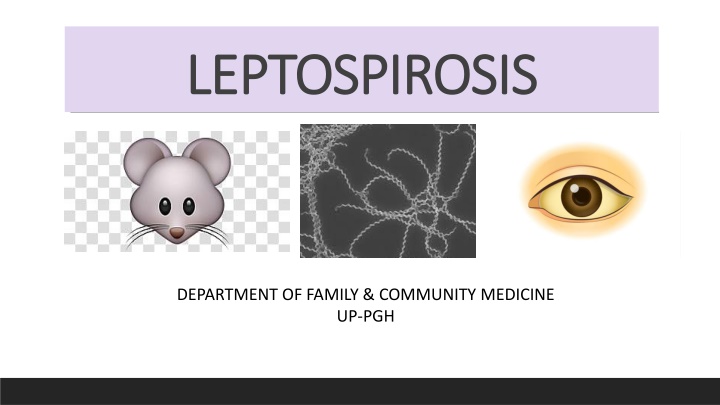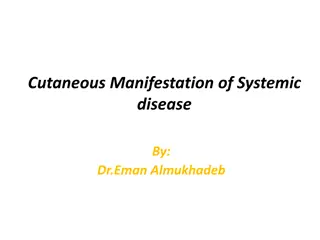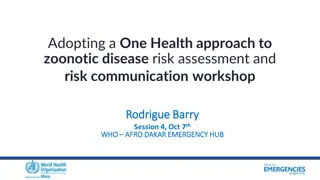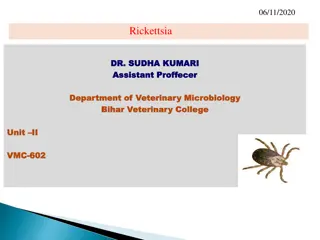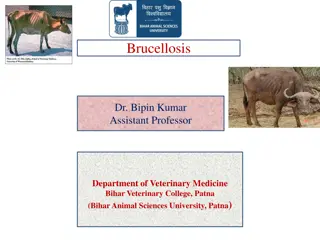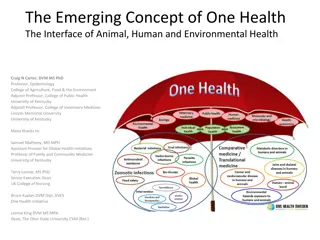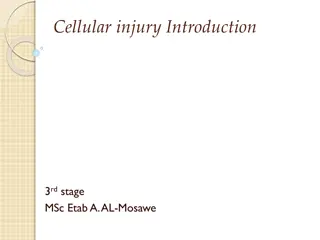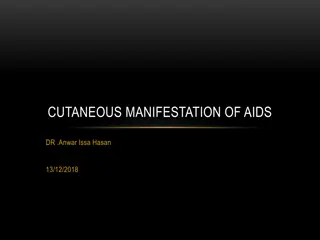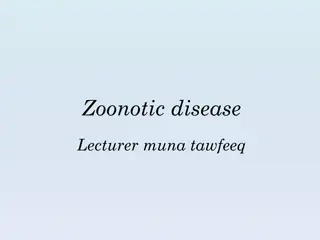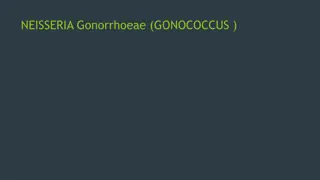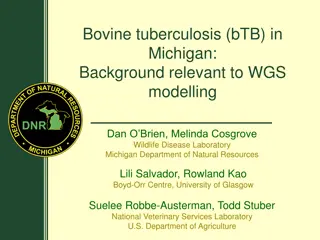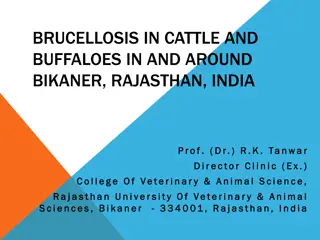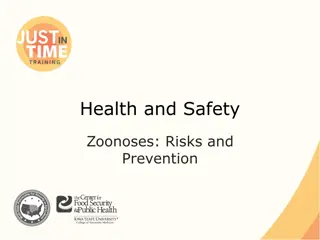Leptospirosis: A Zoonotic Disease with Varied Clinical Manifestations
Leptospirosis is a zoonotic disease caused by pathogenic spirochetes of the genus Leptospira. It presents with diverse clinical manifestations and is prevalent in both temperate and tropical regions. Factors like occupational exposure, recreational activities, and household contact increase the risk of contracting the disease. Microbiologically, Leptospira consists of 22 species, with 10 being pathogenic. The illness typically progresses in two phases, with an acute febrile bacteremic phase followed by an immune phase. Clinical manifestations include acute fever and exposure to contaminated water sources.
Download Presentation

Please find below an Image/Link to download the presentation.
The content on the website is provided AS IS for your information and personal use only. It may not be sold, licensed, or shared on other websites without obtaining consent from the author.If you encounter any issues during the download, it is possible that the publisher has removed the file from their server.
You are allowed to download the files provided on this website for personal or commercial use, subject to the condition that they are used lawfully. All files are the property of their respective owners.
The content on the website is provided AS IS for your information and personal use only. It may not be sold, licensed, or shared on other websites without obtaining consent from the author.
E N D
Presentation Transcript
LEPTOSPIROSIS LEPTOSPIROSIS DEPARTMENT OF FAMILY & COMMUNITY MEDICINE UP-PGH
LEPTOSPIROSIS Leptospirosis is a zoonosis with protean clinical manifestations caused by pathogenic spirochetes of the genus Leptospira. Other names: Weil's disease, Weil-Vasiliev disease, Swineherd's disease, rice-field fever, waterborne fever, nanukayami fever, cane-cutter fever, swamp fever, mud fever, Stuttgart disease, and Canicola fever.
EPIDEMIOLOGY Widespread and prevalent zoonotic disease. Occurs both in temperate and tropical regions (10 times higher in tropical countries).
RISK FACTORS Occupational exposure Farmers, ranchers, abattoir workers, trappers, veterinarians, loggers, sewer workers, rice farmers, pet traders, military personnel, laboratory workers Recreational activities Freshwater swimming, canoeing, kayaking, trail biking Household exposure Pet dogs, domesticated livestock, rainwater catchment systems, infestation by infected rodents Other Walking barefoot through surface water, skin lesions, contact with wild rodents, accidental laboratory exposure
MICROBIOLOGY Leptospira contains 22 species: 10 are pathogenic (L. interrogans, L. kirschneri, L. noguchii, L. alexanderi, L. weilii, L. alstonii, L. borgpetersenii, L. santarosai, L. kmetyi and L. mayottensis) Spiral-shaped, highly motile aerobic spirochetes with 18 or more coils per cell. They tend to stain poorly with common laboratory stain and are best visualized by dark field microscopy, silver stain or fluorescent microscopy.
LEPTOSPIROSIS BIPHASIC ILLNESS 1ST PHASE Acute febrile bacteremic phase lasting 2 to 9 days. 2nd PHASE Immune Phase characterized by renewed fever and development of complications. Leptospires are absent in the blood but may appear in the urine.
CLINICAL MANIFESTATIONS Acute fever of at least 2 days Residing in a flooded area OR has high risk exposure (defined as wading in floods and contaminated water, contact with animal fluids, swimming in flood water or ingestion of contaminated water with or without cuts or wounds) Presenting with at least 2 of the following symptoms: myalgia calf tenderness conjunctival suffusion chills o abdominal pain o headache o jaundice o oliguria
CLINICAL MANIFESTATIONS Other manifestations: Productive cough Nausea Vomiting Diarrhea Splenomegaly Lymphadenopathy
CLASSIFICATION OF LEPTOSPIROSIS CLASSIFICATION OF LEPTOSPIROSIS MILD MODERATE SEVERE fever myalgia headache Nonproductive cough Maculopapular rash Stable vital signs Unstable vital signs Hypotension No jaundice/anicteric sclerae Jaundice/icteric sclerae Good urine output Oliguria/anuria Renal failure (Weil s disease) No meningeal irritation Meningismus, meningeal irritation No sepsis Sepsis/septic shock Nausea, vomiting, diarrhea Conjunctival suffusion Severe calf pain Abdominal pain Altered mental states Hemorrhage (pulmonary) Myocarditis
DIAGNOSIS INDIRECT DETECTION METHODS: DIRECT METHODS: Microagglutination Test (MAT) - 4 fold rise of titer from acute to convalescent sera - in endemic areas, a single titer of at least 1:1600 in symptomatic patients is indicative of leptospirosis. Culture & Isolation (Gold standard) PCR for early confirmation of the diagnosis IgM Rapid Diagnostic Tests (during the acute leptospiremic phase) - LeptoDipstick, Leptospira IgM ELISA, MCAT, Dridot
Other Laboratory tests: CBC with platelet leukocytosis with neutropenia, thrombocytopenia (<100,000) Urinalysis pyuria, proteinuria, hematuria Serum crea may indicate impending AKI CPK-MM Liver function tests slightly elevated SGPT, SGOT, alk phos, bilirubin PT, aPTT prolonged Serum K ABG metabolic acidoses with hypoxemia Chest xray may show alveolar infiltrates 12 L ECG signs of heart block, repolarization, mycoarditis
CRITERIA FOR HOSPITAL ADMISSION Unstable vital signs altered mental status jaundice/icteric sclerae difficulty of breathing abdominal pain hemoptysis nausea, vomiting, diarrhea oliguria, anuria meningismus/meningeal irritation sepsis/septic shock
CAN BE MANAGED AT THE OUTPATIENT SETTING stable vital signs anicteric sclerae, no jaundice good urine output no meningismus no sepsis no DOB can take oral meds
TREATMENT MILD DISEASE SEVERE DISEASE - Doxycycline 100mg BID for 7 days (adult) 2mg/kg per day in 2 divided doses not to exceed 200mg daily (children) - Penicillin 1.5M units IV every 6 hours - Doxycycline 100mg IV daily - Ceftriaxone 1 to 2g IV OD - Cefotaxime 1g IV every 6 hours - Azithromycin 500mg OD for 3 days (adult) 10mkd on D1, 5mkd on succeeding days (children) *Antibiotic therapy should be started as soon as the diagnosis of leptospirosis is suspected regardless of the phase of the disease or duration of symptoms
JARISCH-HERXHEIMER REACTION - Occurs 24 hours following antimicrobial therapy for leptospirosis. - An acute inflammatory response to clearance of spirochetes from the circulation and is characterized by fever,rigors and hypotension. - Results from accelerated phagocytosis by PMN leukocytes, followed by the release of lipoproteins, cytokines and immune complexes from killed organisms. TREATMENT: NSAIDS or other antipyretics
PRE-EXPOSURE PROPHYLAXIS not routinely recommended for individuals who intend to visit highly endemic areas and are likely to be exposed (e.g. soldiers, engaged in water-related recreational & occupational activities) DOXYCYCLINE 100mg/tab 2 tabs ONCE WEEKLY to begin 1-2 days before exposure & continued throughout period of exposure
POST EXPOSURE PROPHYLAXIS LOW RISK EXPOSURE: - single exposure to flood or contaminated waters without cuts or open wounds - Doxycycline 100mg/cap 2 capsules within 24 72 hours from exposure MODERATE RISK EXPOSURE: - single exposure to flood or contaminated waters with wounds, cuts or open lesions on skin - Doxycycline 100mg/cap 2 capsules once daily for 3-5 days within 24 72 hours from exposure HIGH RISK EXPOSURE: - continuous exposure (several days) to flood or contaminated waters with or without wounds, cuts or open lesions on skin; swimming in flooded waters, ingestion of contaminated waters - Doxycycline 100mg/cap 2 capsules once weekly until end of exposure *PREGNANT: Azithromycin 1gm on Day 1, then 500mg on Day 2, 500mg on Day 3
